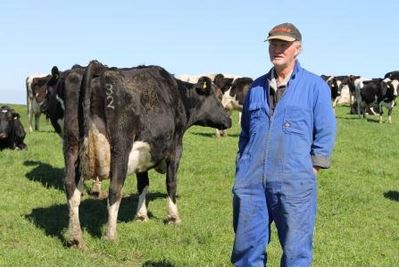



High Protein Ration Paying Dividends For Holstein Friesians
New Zealand producers considering breeding for the coming year have been told to consider the Holstein Friesian for all-round profitability, high protein milk and merits for land efficiency and beef.With Fonterra's milk payments favouring protein over fat, Doug Courtman, President of Holstein Friesian New Zealand believes Holstein Friesians to be a profit making animal.
This is regardless of whether in a housed, high feed input or pasture system.
For the 2012/13 season, an average of five cents more per kilo of milk solids was earned by the breed at Fonterra's $5.84 base because of its milk being high in protein compared to fat.

He explained that, using the figures presented by Fonterra in July 2014, the breed could earn eight cents more than the $8.40 payout for the 2013/14 season - applying the 2012/13 production statistics.
“The value of protein was almost double that of fat in Fonterra’s milk payment for last season [2013/14],” Doug explained that the VCR (Valued Component Ratio) was 0.51, meaning that fat was worth 51 per cent to that of protein.
“Fonterra has set the VCR for the 2014/15 season at 0.43, which means that protein is worth even more.” Even going into a potentially low milk payment season, the value of protein is more than twice that of milk fat. High volumes of protein will ensure that the Holstein Friesian breed maintains an above average payout, he said.
Arguments against the profitability of Holstein Friesians include that it takes more energy (food) to produce milk and being heavier the cows can do more damage to land.
“Fewer cows, fewer feet, same production,” Doug says to detractors of the breed. He responded that the amount of income from milk produced outweighs the cost of feeding the animal. More milk means fewer animals to the hectare, therefore not as much damage to land.
He clarified further that liveweight was not really an issue, “Bull breeders and breeding companies are breeding bulls to suit the New Zealand dairy industry including a smaller, efficient animal with a lower liveweight to suit pasture based farmers. Alternatively, farmers can have the larger-framed animal that produces more milk if they use a high input system of feeding.”
“The extremes [of size and liveweight] are no longer there,” he said noting that in North America, breeders acknowledge that the cows are getting too big and in type assessments the animals that are too tall are being knocked back.
Fertility is also a misnomer that follows the breed, particularly when overseas bulls are used, “Fertility in the breed is improving all around the world. The bulls brought in [to New Zealand] are selected carefully,” Doug said, “As with any breed or cross, make sure the heifer or cow is in good condition and she will have a much better chance of getting in-calf.”
Doug recalled US-bred bull O-Bee Manfred Justice-ET (otherwise known as O-man) as an example. Not only did O-man make it onto the New Zealand RAS (Ranking of Active Sires) list with a high Breeding Worth he also had one of the highest fertility breeding values at the time (mid-late 2000s) and he still retains a fertility breeding value of +9.1. His New Zealand-bred sons include the well-known Oakura Oman Overdrive marketed by CRV Ambreed with a fertility BV +5.8 and Kailey Oman Kracka-ET marketed by LIC with a fertility BV +6.2.
The live export of Holstein Friesians to Asia is still buoyant. LIC and Fonterra are contract mating for heifer calves, using sexed semen, which they purchase for $500 at four-days-old for export. Doug cautions farmers that it is still important to keep the best genetics in New Zealand and farmers should take careful note of what animals they are sending overseas for a quick buck.
“In the long term, it could be to the detriment of the national dairy herd if the best purebred animals are sent to China and substandard genetics remain in New Zealand.”
Other sources of income that the Holstein Friesian breed offers to farmers includes the sale of bull calves that often make it into the national beef herd as well as any heifer calves that are a crossed with beef. Bobby calves and cull cows also have an increased value over smaller breeds or cross-bred animals.


